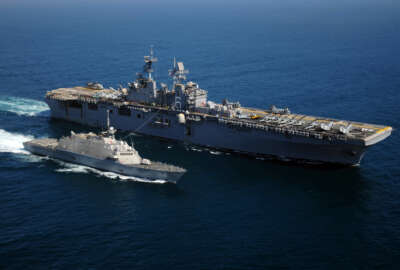
Navy gets savvy with contracting rules to avoid maintenance problems due to CR
The Navy has a few tricks up its sleeve to award contracts in a time when new starts aren't allowed.
The Navy is making progress on repairs it needs to make on its fleet of ships.
The service is seeing a 75 percent reduction in the days that ships are unable to be operational due to maintenance issues or repairs since 2014, said Real Adm. James Downey, deputy commander for surface warfare at the Navy Regional Maintenance Center.
“Coming through 2014, it was nearly 5,000 lost operational days, 4,900 and change,” Downey said during a Jan. 11 speech at the Surface Naval Association Conference in Arlington, Virginia. “As of November 2017, we closed out at about 1,165 lost operational days. We are still not where we need to be. The 75 percent reduction over the last three to four years is principally due to efforts put in place by my predecessors on process, on standing up various planning activities and on strategy.”
Last year, Vice Chief Naval Officer Bill Moran warned that putting off maintenance on ships is detrimental to the Navy.
“Deferred maintenance is insidious, it takes a toll on the long-term readiness of the fleet,” Moran said.
The Navy has put a strong emphasis on maintaining its current fleet in the recent past and present. The service received more than $8 billion for ship maintenance in 2017, about $3 billion of that was in one-time emergency war spending, and requested about $7 billion in base budget spending for maintenance in 2018.
With maintenance money tied up in the current continuing resolution, it’s hard to believe the Navy is still making headway on its maintenance issues.
The Navy has 57 ships it needs to award contracts for maintenance in 2018.
“We don’t have the money on the books to award those contracts,” Downey said.
But, the Navy has found a work-around with modernization money.
Money appropriated for modernization of a ship doesn’t have to be used for three years, meaning it can be used to start a new contract during a continuing resolution. In most cases continuing resolutions bar new contracts from happening.
“We’ve changed how we contract for ships. Maintenance is not the core, the base, for what the contract is,” Downey said. “Modernization money is three-year money. I have that money in most cases to go forward. The base of the contract in some cases is now the modernization work for a maintenance availability and the maintenance work is an option, which we execute if we get [maintenance appropriations] just in time. Which, to date, we have. The CR efforts have caused us to restructure our acquisition approach. They’ve had an effect on long lead time and material.”
Basically, the flexibility with modernization money allows the Navy to compete and award a contract, which is a time-exhausting process, and then to ask the company that was awarded the contract to perform maintenance on a ship for extra money if the budget issue gets resolved in time.
So far, Congress has sorted out its issues in time to pay for those contract options. The options also allow the Navy to stay on schedule with maintenance because they don’t have to wait to get money from Congress before they compete a contract.
The savvy thinking is the new reality the Navy is living in as CRs become more of a norm than an anomaly.
“It tends to make people think, ‘You’ve awarded them all, it doesn’t have an effect.’ It does have an effect. We are meeting a fleet demand signal with many different iterations and just in time, so not as efficient as we could be if it was funded off of an approved budget,” Downey said.
Rear Adm. Mark Whitney, director of fleet maintenance, said he hasn’t awarded any maintenance contracts this year for ships under his domain, but if the CR continues that issue could cause serious schedule problems.
Copyright © 2025 Federal News Network. All rights reserved. This website is not intended for users located within the European Economic Area.
Scott Maucione is a defense reporter for Federal News Network and reports on human capital, workforce and the Defense Department at-large.
Follow @smaucioneWFED





